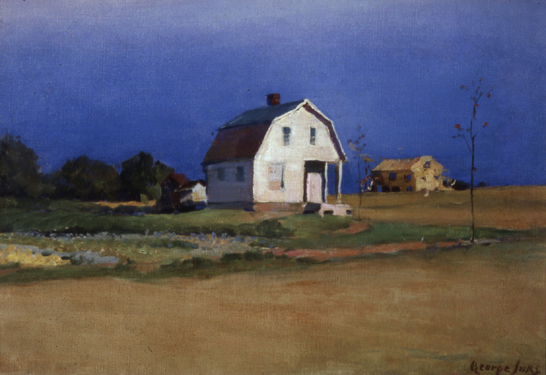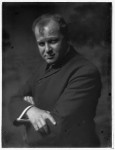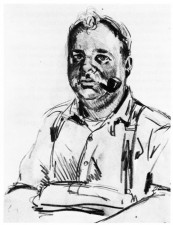
George Luks
American, 1867-1933
The Haunted House, 1925-1930 ca.
oil on canvas
13 1/4 x 19 in.
SBMA, Gift of the Women's Board
1960.47

George Luks, c.1910, photograph by Gertrude Käsebier.
"At sixty a man has passed most of the reefs and whirlpools. Excepting only death, he has no enemies left to meet. . . . That man has awakened to a new youth. . . . Ergo, he is young." - George Luks
RESEARCH PAPER
George Luks’ The Haunted House is a small (13x19 inches) painting in oil on canvas. It was purchased by the Women’s Board and given to the Santa Barbara Museum of Art in 1960. Its earlier history is unknown. The painting was cleaned and remounted to a new stretcher in 1992.
George Luks was born in Williamsport, Pennsylvania, in 1866 and studied briefly at the Pennsylvania Academy of Fine Arts. He made several trips to Europe during the 1890s, studying for a short time at the Dusseldorf Academy. In 1894 he returned to the United States and worked as an artist-reporter for The Philadelphia Press, along with William Glackens, John Sloan and Everett Shinn. Prior to 1900, newspapers lacked the technology to print photographs, so they employed artist-reporters to make quick, on-the-spot drawings of newsworthy events.
Artist Robert Henri befriended Luks, Glackens, Sloan and Shinn and, when the group moved to New York, became their artistic mentor. He persuaded Luks to take up painting. Henri was greatly impressed with the illustrators’ ability to sketch and paint quickly, and building on the realist tradition of Eakins, the group went out into the streets of New York to paint images of urban American life, complete with its seedier aspects. In 1908, Luks exhibited his work in New York as one of “The Eight.” He is considered one of the New York Realists, to whom a critic gave the derogatory nickname, The Ashcan School.
Luks was the most colorful and notorious member of The Eight. He was a loud and famous braggart, teller of tales, drinker, and barroom brawler. He greatly admired the work of 17th century Dutch Realist Frans Hals, whose influence is clear in Luks’ best known paintings. Luks’ street scenes and portraits of lower class “types” – coal miners, slum dwellers, and dirty children playing in the streets – have the freeze-frame quality of capturing a real moment. They are painted in a dark, rich palette with quick, sharp, spontaneous brushstrokes. These are the paintings which brought him fame, and which appear to this day in art anthologies as examples of his work. Though revolutionary for their content in 1908, Luks’ paintings appeared almost old-fashioned only five years later, after the Armory Show of 1913 inspired a younger generation of artists toward modernism. Luks detested modernism and continued to paint his “American characters” and street scenes, though he did begin to heighten the intensity of his colors and paint landscapes and watercolors during the 1920’s.
The Haunted House is significant in that it represents the later, less well-known work of Luks, which includes some of his best pieces. It was painted toward the end of his life, between 1925 and 1930, probably in the Berkshires, where he spent a great deal of time in his later years. Several examples of similar scenes and similar use of color exist from this time, both in oil and watercolor. As with his urban scenes, Luks’ approach here is a direct, energetic, and quickly rendered portrayal of an ordinary subject. His strong feeling for the dramatic is evident, as he infuses this old house with a sense of mystery and power. But perhaps most impressive is his beautiful and masterful use of color. It is interesting to note that Luks created many watercolor scenes at this time, which are also remarkable for their color. Here we see him using oil paint almost as watercolor. The barren foreground and the sky are painted with layers of thinned, wash-like paint that allows the canvas to show through. The brilliant blue sky takes up half the canvas and the rich tones of the earth comprise the lower third. The sunlit white face of the house stands brightly in the center. These colors are gorgeous and warm, yet their sheer uninterrupted planes give the painting a strong sense of barrenness and desolation. The house, also barren, has great presence and character. Though simple and abandoned, it has importance and weight, as did Luks’ famous characters. It is also, in its starkness and use of light, a vision very similar to works by Edward Hopper, who was coincidentally a student of Robert Henri.
Unfortunately, Luks was never to realize his full potential as an artist. The Haunted House was painted well past the artist’s prime, at a time when his work took on a haphazard, hit or miss quality, undoubtedly due to his alcoholism. There is a carelessness evident in The Haunted House that is typical of Luks. The gold building in the background is simply sloppy – paint has apparently been misapplied and smudged and not corrected. This might explain in part why Luks is given almost footnote status compared to other members of The Eight. There was a burst of renewed interest in Luks in the 1970’s as his watercolors were rediscovered, and he has since received some well-deserved notice as a colorist.
Prepared for the Santa Barbara Museum of Art Docent Council by Kathryn Zupsic, March 27, 1997.
Typed and edited for the website by Joan Dewhirst and Lori Mohr, fall, 2012.
BIBLIOGRAPHY
ACA Galleries, “19th and 20th Century Masterpieces in New York Private Collections,”
September 26 – October 14, 1978.
ACA Heritage Gallery, Inc., New York, ”George Luks,” November 27 – December 23, 1967.
Goddard, Donald, “American Painting,” Hugh Lauter Levin Associates, Inc., New York, 1990.
Glackens, Ira, “William Glackens and the Eight,” Horizon Press, New York, 1957.
Milwaukee Art Museum, “Painters of a New Century: The Eight,” September 6 – November 3, 1991.
Museum of Art, Munson-Williams-Proctor Institute, “George Luks,” April 1 – May 20, 1973.
Olan Gallery, Bronx, New York, “George Luks Drawings,” Catalog #13 (undated).
Young, Mahonri Sharp, “The Eight,” Watson-Guptill Publications, New York, 1973.

Self-portrait by George Luks, 1893, graphite. Collection the Hirshhorn, Smithsonian American Art Museum, Washington, DC.
SBMA CURATORIAL LABELS
In some ways, Luks inhabited the prototypical persona of the avant-garde American artist: from a working- class family, he discovered the arts through a year spent at the Pennsylvania Academy of Fine Art. Travel to the sophisticated art meccas throughout Europe opened his eyes to cutting-edge art. Though Luks started out as an illustrator and a journalist, through the influence of the charismatic artist, Robert Henri (1865-1929), he took up painting in 1897 at the relatively late age of 30. He was a member of the so-called Eight, who exhibited with Henri and were dubbed by critics the Ashcan School, because of the gritty realism of their subject matter.
This is an example of Luks’ more idiosyncratic late style, which is typically considered to be less rigorous as the artist’s health declined. Nevertheless, the eerily airless landscape resonates with the mystery of his chosen motif – a purportedly haunted house, plucked purposefully from the landscape of the Berkshires, where he spent his last years. Luks’ summary style gets down the shimmering warmth of the sun and cloudless sky, which contrast expressively with the stark shadows that outline the ominously deserted house.
- Small-Format American Paintings, 2020

Recommended for further research is a book published in 2009 in conjunction with the exhibition The Eight and American Modernisms organized by the Terra Foundation for American Art. (Especially a chapter titled George Luks: Rogue Raconteur and Realist with excellent color reproductions of Luks’ paintings, including his Self-Portrait with Pince-Nez)
Terra Foundation for American Art, Chicago, The Eight and American Modernisms, University of Chicago Press, Chicago, 2009.
Lori Mohr